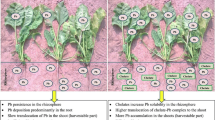
Overview
- Describes the distribution of lead in the environment
- The effect of lead toxicity on human health
- Covers all possible solutions of lead bioremediation
Part of the book series: Environmental Contamination Remediation and Management (ENCRMA)
Buy print copy
About this book
This edited book brings together a diverse group of researchers to address the challenges posed by global mass poisoning caused by lead contamination of soil and plants. Lead is among the elements that have been most extensively used by man over time. This has led to extensive pollution of surface soils on the local scale, mainly associated with mining and smelting of the metal and addition of organic lead compounds to petrol. Release of lead to the atmosphere from various high-temperature processes has led to surface contamination on the regional and even global scale. Lead is particularly strongly bound to humic matter in organic-rich soil and to iron oxides in mineral soil and is rather immobile in the soil unless present at very high concentrations. In addition, plants grown on lead-rich soils incorporate lead and thus the concentration of lead in crop plants may be increased. Lead enters in the food chain through consumption of plant material. A high concentration of lead has been found to be harmful to vegetation. As the lead concentration increases, it adversely affects several biological parameters and eventually renders the soil barren. The book sheds light on this global environmental issue and proposes solutions to contamination through multi-disciplinary approaches.
This book contains three sections. First section describes the different sources and distribution of lead in soil and plant ecosystems. Second section explains the health risks linked to lead toxicity. Third section addresses sustainable lead toxicity mitigation strategies using the potential applications of recent biological technology.
This book is a valuable resource to students, academics, researchers, and environmental professionals doing field work on contamination throughout the world.
Similar content being viewed by others
Keywords
Table of contents (14 chapters)
-
Front Matter
-
Source and Distribution of Lead in Soil and Plant Ecosystem
-
Front Matter
-
-
Health Risks Linked to Lead Toxicity
-
Front Matter
-
-
Sustainable Mitigation Strategies of Lead Toxicity
-
Front Matter
-
-
Back Matter
Editors and Affiliations
About the editors
Dr. Nitish Kumar is Senior Assistant Professor at the Department of Biotechnology, Central University of South Bihar, Gaya, Bihar, India. Dr. Kumar completed his doctoral research at the Council of Scientific & Industrial Research–Central Salt & Marine Chemicals Research Institute, Bhavnagar, Gujarat, India. He has more than 12 years of research and teaching experience in the field of plant and microbial biotechnology and bioremediation. He has published more than 70 research articles in leading international and national journals, more than 20 book chapters and 7 books with Springer and Taylor & Francis. He has received many awards/fellowships/projects from various organizations, for example, the CSIR, DBT, ICAR and SERB-DST, BRNS-BARC, among others. He is Active Reviewer for journals, including Biotechnology Reports, Aquatic Botany, Industrial Crops and Products, PLoS One, Plant Biochemistry and Biotechnology, and 3Biotech. He also serves as Associate Editor of the Journal Gene (Elsevier).
Dr. Amrit Kumar Jha is Scientist (Soil Science) and Head at Krishi Vigyan Kendra, Sahibganj, Birsa Agricultural University, Ranchi, Jharkhand, India. Dr. Jha completed his doctoral research in subject Soil science and Agricultural Chemistry from Birsa Agricultural University, Ranchi, Jharkhand, India. He has more than 18 years of research experience in the field of soil chemistry, soil fertility, and soil pollution. He has published more than 40 research articles in leading international and national journals, more than 11 technical bulletins and 2 books. He has received many awards such as Young Scientist Award conferred by Society of Krishi Vigyan in 2018, Best KVK Scientist Award conferred by Indian Society of Extension Education in 2018, and Best KVK Scientist Award conferred by Society of Krishi Vigyan in 2020.
Bibliographic Information
Book Title: Lead Toxicity Mitigation: Sustainable Nexus Approaches
Editors: Nitish Kumar, Amrit Kumar Jha
Series Title: Environmental Contamination Remediation and Management
DOI: https://doi.org/10.1007/978-3-031-46146-0
Publisher: Springer Cham
eBook Packages: Biomedical and Life Sciences, Biomedical and Life Sciences (R0)
Copyright Information: The Editor(s) (if applicable) and The Author(s), under exclusive license to Springer Nature Switzerland AG 2024
Hardcover ISBN: 978-3-031-46145-3Published: 02 January 2024
Softcover ISBN: 978-3-031-46148-4Due: 15 January 2025
eBook ISBN: 978-3-031-46146-0Published: 01 January 2024
Series ISSN: 2522-5847
Series E-ISSN: 2522-5855
Edition Number: 1
Number of Pages: XIII, 337
Number of Illustrations: 3 b/w illustrations, 25 illustrations in colour
Topics: Biotechnology



